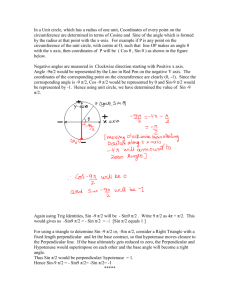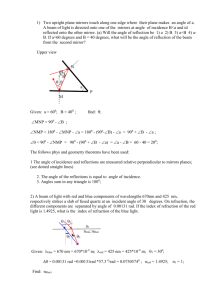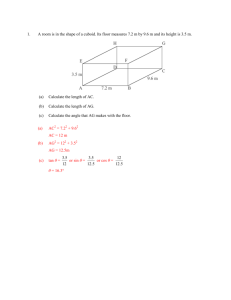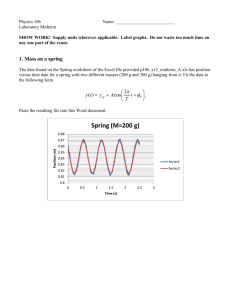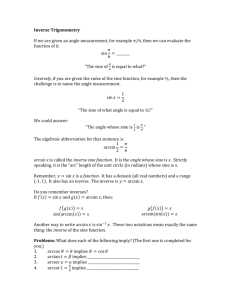Grade 11 Physical Science Class Test April 2015
advertisement
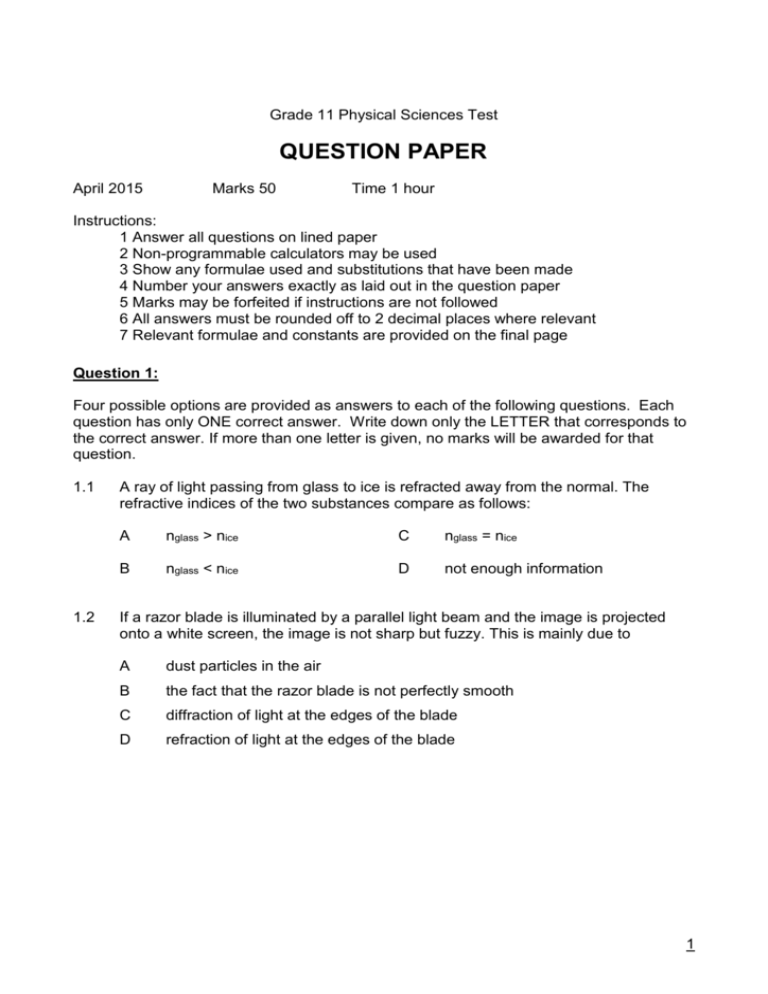
Grade 11 Physical Sciences Test QUESTION PAPER April 2015 Marks 50 Time 1 hour Instructions: 1 Answer all questions on lined paper 2 Non-programmable calculators may be used 3 Show any formulae used and substitutions that have been made 4 Number your answers exactly as laid out in the question paper 5 Marks may be forfeited if instructions are not followed 6 All answers must be rounded off to 2 decimal places where relevant 7 Relevant formulae and constants are provided on the final page Question 1: Four possible options are provided as answers to each of the following questions. Each question has only ONE correct answer. Write down only the LETTER that corresponds to the correct answer. If more than one letter is given, no marks will be awarded for that question. 1.1 1.2 A ray of light passing from glass to ice is refracted away from the normal. The refractive indices of the two substances compare as follows: A nglass > nice C nglass = nice B nglass < nice D not enough information If a razor blade is illuminated by a parallel light beam and the image is projected onto a white screen, the image is not sharp but fuzzy. This is mainly due to A dust particles in the air B the fact that the razor blade is not perfectly smooth C diffraction of light at the edges of the blade D refraction of light at the edges of the blade 1 1.3 The diagram below shows plane water waves that spread out after passing through a single slit. The wave phenomenon observed after the water waves pass through the slit is… 1.4 A reflection C refraction B diffraction D Huygens principle Which ONE of the following properties is not a property of an ideal gas? A There are no forces of attraction between the molecules B The collisions between the molecules are perfectly elastic C The volume occupied by the gas is equal to the total volume of the molecules D The product of the pressure and the volume of the gas is constant at constant temperature. Which ONE of the following sketch graphs is an incorrect representation of Boyle’s Law? 1.5 p p V A pV p 1/V B V V C D [5 x 2 = 10] 2 Question 2: 2.1 Define the term critical angle (2) 2.2 List the TWO conditions required for total internal reflection to take place (2) Light pass through a layer of ice into air (nair = 1) . 2.3 If the light travels through the ice at 2,29 x 108 m∙s-1, calculate the refractive index of ice. (3) Two light rays, A and B, are shone at the surface at the angles indicated in the diagram. air air ice ice 30o 55o B A 2.4 Show by calculation that the angle of refraction for light ray A is 40,92o (3) 2.5 Calculate the critical angle for the ice/air boundary. (3) 2.6 Sketch the path of light ray B. The diagram does not need to be drawn to scale, but all angles must be shown. (2) [15] 3 Question 3: Learners investigate the change in the broadness of the central bright band formed when monochromatic light of different wavelengths passes through a single slit. They set up the apparatus as shown in the diagram below, and measure the broadness of the central bright band in the pattern observed on the screen. The width of the slit is 5,6 x 10-7 m 3.1 Give an investigative question for this experiment. (2) 3.2 Which TWO variables must be kept constant? (2) 3.3 How will the broadness of the central bright band of red light compare with that of blue light? Write down only GREATER THAN, SMALLER THAN or EQUAL TO. (1) Give a reason for your answer to QUESTION 3.3 (2) 3.4 [7] Question 4: 4.1 State Boyle’s Law in words (2) 4.2 A balloon is filled up with 4,6 dm3 of air at sea-level. It is then attached to a submarine and taken to a depth of 120 m, where the pressure is approximately 1,31 x 103 kPa. If the temperature is kept constant, calculate the volume of the balloon at this depth. (3) Using the kinetic theory of matter, explain why the pressure of a gas is inversely proportional to the volume of the gas if the temperature is kept constant. (3) 4.3 4.4 List ONE assumptions about ideal gases that are not always true for real gases (1) [9] 4 Question 5: In the diagram below, a battery with an emf of 12 V is connected to a circuit containing two resistors in parallel and a device which operates with a power of 8 W. The internal resistance of the battery is unknown. If the resistance of the device is 2 , calculate: 5.1 The reading on A1. (3) 5.2 The equivalent resistance of the parallel combination of resistors. (2) 5.3 The internal resistance of the battery. (4) [9] Bonus Question: (Only attempt this when you have finished all other questions) How much current would be required to charge all the cell phones in the school if they were plugged in in parallel? Assume that a typical cell phone has a resistance of around 50 . Show all estimations and calculations. [1] Total: [50] 5 Formulae Circuits 1 1 1 Reff R1 R2 V IR emf I ( Rext rint ) V2 W P VI I R R t 2 V2 W VI t I Rt t R 2 Gases p1V1 p2V2 Light c v n1 sin 1 n2 sin 2 n sin cr sin c 3 108 m s 1 n2 n1 m w 6 Memo: Question 1 1.1 A 1.2 C 1.3 B 1.4 C 1.5 A Question 2 2.1 It is the angle of incidence beyond which a ray will reflect back into a medium instead of refracting. 2.2 i) ii) 2.3 n The angle of incidence must be greater than the critical angle The medium that the light travels from must have a greater refractive index tan the medium it travels into c v 3 108 2, 29 108 1,31 2.4 n1 sin 1 n2 sin 2 (1,31)sin(30) (1)sin 2 2 arcsin(0, 655) 40,92 2.5 n2 n1 cr arcsin 1 arcsin 1,31 49, 76 2.6 55o 55o 7 Question 3 3.1 How does the wavelength affect the broadness of the central bright band. 3.2 Slit width Distance from screen 3.3 Greater than 3.4 The greater the wavelength, the greater the angle of diffraction. Red light has a longer wavelength than blue light Question 4 4.1 The pressure of a gas is inversely proportional to the volume the gas occupies, provided the temperature remains constant. p1V1 p2V2 4.2 (101,3)(4, 6) (1,31103 )V2 V2 0,36 dm3 4.3 If the volume of a gas is decreased, then the particles will collide with the walls more frequently. This means that there will be a greater force exerted on the walls, and so the pressure will increase. 4.4 One of: Ideal gases experience forces only when they collide Particles have no volume Particles are all identical 8 Question 5 5.1 P I 2R 8 I 2 (2) I 4 2 A 5.2 1 1 1 Reff R1 R2 1 1 12 4 4 12 3 Reff 5.3 emf I ( Rext r ) 12 (2)(2 3 r ) 6 5 r r 1 Bonus No of phones is bout 900 Voltage in charger is around 5-10 V Current in charger is around V R 5 50 0,1 A I So total is current is around 0,1*900 = 90 A. Accept answer between 50 A and 200 A. 9
